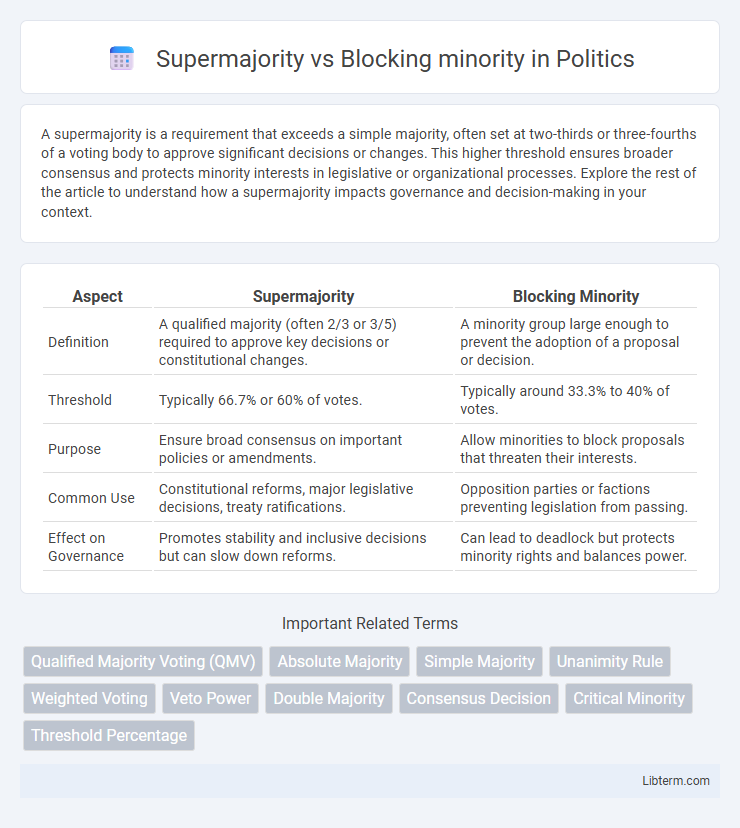A supermajority is a requirement that exceeds a simple majority, often set at two-thirds or three-fourths of a voting body to approve significant decisions or changes. This higher threshold ensures broader consensus and protects minority interests in legislative or organizational processes. Explore the rest of the article to understand how a supermajority impacts governance and decision-making in your context.
Table of Comparison
| Aspect | Supermajority | Blocking Minority |
|---|---|---|
| Definition | A qualified majority (often 2/3 or 3/5) required to approve key decisions or constitutional changes. | A minority group large enough to prevent the adoption of a proposal or decision. |
| Threshold | Typically 66.7% or 60% of votes. | Typically around 33.3% to 40% of votes. |
| Purpose | Ensure broad consensus on important policies or amendments. | Allow minorities to block proposals that threaten their interests. |
| Common Use | Constitutional reforms, major legislative decisions, treaty ratifications. | Opposition parties or factions preventing legislation from passing. |
| Effect on Governance | Promotes stability and inclusive decisions but can slow down reforms. | Can lead to deadlock but protects minority rights and balances power. |
Introduction to Supermajority and Blocking Minority
Supermajority and blocking minority are critical concepts in corporate governance and decision-making processes. A supermajority requires a higher threshold, typically two-thirds or three-quarters of votes, to approve significant decisions, ensuring broader consensus. Blocking minority refers to a smaller group of shareholders whose voting power is sufficient to prevent the adoption of a proposal, protecting minority interests against unilateral control.
Defining Supermajority: Meaning and Thresholds
A supermajority refers to a requirement that exceeds a simple majority, often set at two-thirds, three-fourths, or even higher proportions of votes, depending on the specific decision or organization's rules. This threshold ensures that significant consensus is achieved for critical resolutions, such as constitutional amendments or major corporate actions. Unlike a blocking minority, which represents a smaller group able to prevent decisions, a supermajority mandates a larger, more substantial agreement among members.
Understanding Blocking Minority: Concept and Significance
A blocking minority is a strategic voting threshold that prevents the adoption of a proposal despite a majority favoring it, often requiring a minimum percentage of votes or shares to veto decisions. This concept is crucial in corporate governance and political systems to protect minority interests and ensure that significant changes receive broad consensus. Understanding the significance of a blocking minority helps stakeholders balance power dynamics and safeguard against unilateral decision-making by a simple majority.
Common Contexts: Where Supermajority Is Required
Supermajority requirements are common in corporate governance, particularly for critical decisions such as amending bylaws, approving mergers, or authorizing large financial transactions. In legislative bodies, supermajorities are necessary for constitutional amendments, overriding vetoes, and passing certain types of legislation to ensure broader consensus beyond a simple majority. These contexts prevent decisions by a narrow majority and require substantial agreement to protect minority interests and ensure stability.
Typical Scenarios for Blocking Minority in Decision-Making
Blocking minority typically occurs in corporate governance when a minority shareholder group holds enough shares to prevent the formation of a supermajority, often set at around 75% approval. This scenario is common in decisions requiring significant changes, such as mergers, acquisitions, or amendments to the company's bylaws, where the blocking minority can halt approval despite majority support. It ensures minority protection by requiring broader consensus, impacting negotiations and strategic planning within boardrooms.
Legal and Political Applications
A supermajority requires a significantly higher threshold of votes, often two-thirds or three-quarters, to approve key legal or political decisions, ensuring broad consensus and stability. Blocking minority refers to a minority group that possesses enough votes to prevent a decision or proposal from passing, thereby exerting substantial influence in legislative or corporate governance contexts. In constitutional law and parliamentary procedure, these mechanisms balance power by facilitating major agreement while protecting minority rights from unilateral dominance.
Impact on Democratic Processes
Supermajority requirements enhance democratic processes by ensuring that significant decisions represent broad consensus, reducing the risk of majoritarian tyranny. Blocking minorities empower minority groups to prevent decisions that could marginalize their interests, fostering inclusive deliberation and protecting minority rights. Balancing supermajority and blocking minority mechanisms strengthens democratic legitimacy by promoting both majority rule and minority protections in governance.
Advantages and Disadvantages of Supermajority
A supermajority requirement enhances decision-making stability by ensuring broad consensus and preventing rash or narrowly supported actions, which reduces the risk of factional influence. However, the disadvantage lies in its potential to stall progress and create gridlock, as achieving the high threshold for approval can be difficult, especially in diverse or polarized groups. This balance between inclusivity and efficiency makes supermajorities suitable for critical decisions but less practical for routine governance.
Pros and Cons of Blocking Minority
Blocking minority enables a smaller group of shareholders to prevent decisions that may negatively impact their interests, promoting balance and protecting minority rights. However, it can also lead to decision-making gridlock, hindering the efficiency and agility of corporate governance. The risk of obstructing beneficial proposals for the broader company may deter potential investors and slow down strategic initiatives.
Conclusion: Balancing Power in Collective Decisions
Supermajority and blocking minority mechanisms play crucial roles in balancing power within collective decisions by ensuring that significant changes have broad support while protecting minority interests from being overridden. Supermajority requirements prevent hasty or controversial decisions by demanding a higher threshold, often two-thirds or three-quarters, fostering consensus and stability. Conversely, blocking minority rights empower smaller groups to halt proposals that could potentially harm their interests, maintaining fairness and preventing dominance by larger factions.
Supermajority Infographic

 libterm.com
libterm.com